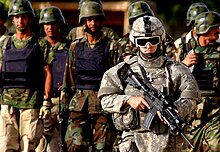Operation Squeeze Play
This article needs additional citations for verification. (July 2008) |
| Operation Squeeze Play | |||||||
|---|---|---|---|---|---|---|---|
| Part of the Post-invasion Iraq | |||||||
| |||||||
| Belligerents | |||||||
|
New Iraqi Army |
Iraqi Insurgents | ||||||
After the handover of sovereignty, Operation Squeeze Play was a combined U.S./Iraqi sweep of the western suburbs of Baghdad launched on 22 May 2005. Almost 300 suspects were detained in the first day of the operation.[1]
It followed

Context
The United States led a coalition force into Iraq to overthrow the

Overview
The goal of this operation was to raid Eastern Baghdadi cities and detain anybody linked to terrorism in hopes of fighting terror in the capital of Iraq.
The Role of the United States
The United States led the coalition force into Iraq. Specifically in Operation Squeeze Play, the units that were involved in this operation were two battalions from the 3rd Brigade, 6th Iraqi Army Division along with two battalions from the 1st Brigade, 1st Iraqi Intervention Force. Not only did the United States provide these units they also provided three battalions from the 2nd Brigade Special Police Commandos and Soldiers from Task Force 2-14, 2nd Brigade Combat Team, 10th Mountain Division.[5] The United States alone provided more than 900 troops to this operation; these consisted of soldiers, marines, pilots, and sailors. These 900 Americans were tasked with regaining ground in Iraq to prevent the spread of terrorism.[4] American officials believed that if they withdrew troops from Eastern Baghdad after the operation that the city would fall to terrorism immediately. After the clearance of the city, Americans began training the Iraqi military and police force in hopes that they will be strong enough to fight off insurgents if they tried retaking that portion of Baghdad. With these efforts, military officials began telling residents of the city the true hopes of the insurgents; the insurgents only want the city to continue their terroristic attacks.[2]
The Role of the Iraqi Forces
Iraqi forces and the American military worked together during this operation to see the detaining of 400 suspects in what was a productive 48 hours for the coalition forces.[3] Together both forces brought useful information to the table and working together ultimately led them closer to their goal, which was clearing out terror suspects around the Baghdad suburbs. The American military brought over 900 troops and useful technology as well as their massive arsenal.[2] The Iraqi forces were useful in the long term planning of this operation. With the Iraqi military and police force joining the Americans they were able to learn from the Americans techniques on how to establish a stronghold in hopes they would be able to keep terror suspects out of their cities after the United States withdraws their forces. They also provided information on the region but most importantly they provided information on how to detect roadside explosives which were extremely common in Baghdadi cities and offered one of the biggest threats to Americans.[4]
References
- ^ "Seven US soldiers killed in Iraq". BBC News. 24 May 2005. Retrieved 20 July 2008.
- ^ a b c d "Defense.gov News Article: Operation Squeeze Play Aims to Crack Down on Terrorists". archive.defense.gov. Retrieved 12 December 2018.
- ^ a b c "Operation Squeeze Play captures 143 more terrorists". DVIDS. Retrieved 12 December 2018.
- ^ ISSN 0190-8286. Retrieved 12 December 2018.
- ^ "Operation Squeeze Play 2005". www.globalsecurity.org. Retrieved 12 December 2018.
